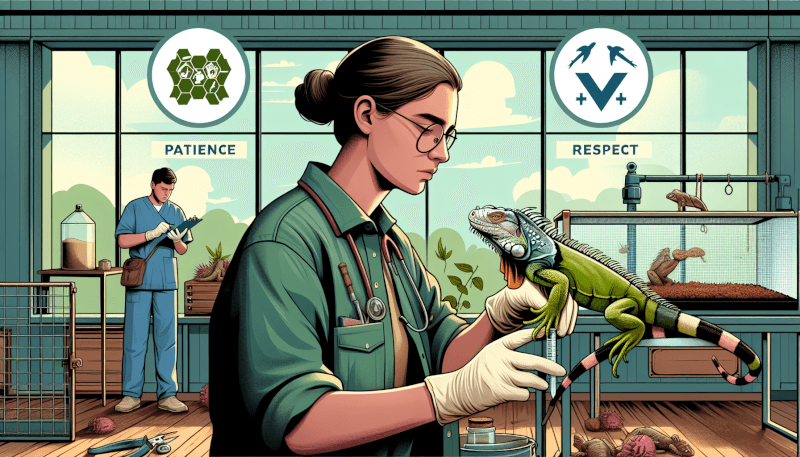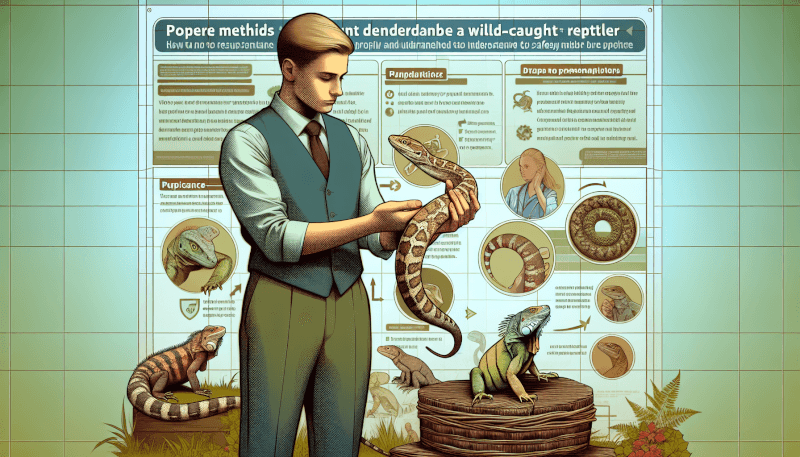If you’ve recently found yourself the proud owner of a wild-caught reptile, you may be wondering how to handle and tame them safely. Whether you’ve adopted a snake, lizard, or turtle, it’s important to approach the process with care and patience. From understanding their natural behavior to providing the right environment and practicing proper handling techniques, this article will guide you on the journey of taming your new scaly friend. Get ready to create a bond that will last a lifetime!
Choosing the Right Equipment
When it comes to handling and taming wild-caught reptiles, one of the first steps is to ensure that you have the right equipment. This includes items such as gloves, hooks, and nets. Researching the species you plan to handle is crucial in determining the specific tools you will need. Some reptiles may require longer or shorter hooks, while others may need specialized gloves for handling. Investing in proper handling tools is essential to ensure both your safety and the reptile’s well-being.
Assessing the Reptile’s Health
Before attempting to handle or tame a wild-caught reptile, it is important to assess its overall health. This involves observing the reptile’s condition, checking for signs of stress, and looking for any external parasites. By evaluating the reptile’s health, you can determine if it is in a suitable condition for handling and if any immediate medical attention is required.

Handling Techniques for Wild-Caught Reptiles
Handling wild-caught reptiles requires a deep understanding of their body language and behavior. It is crucial to approach them with caution and use proper holding techniques to minimize stress. Observing their body language can provide valuable insights into their comfort level and readiness for handling. Avoiding tail and jaw movement is essential to prevent any potential harm to yourself or the reptile.
Building Trust through Taming
Taming a wild-caught reptile involves establishing trust and creating a calm environment. This can be achieved by providing a routine and using positive reinforcement. By progressing at the reptile’s pace, you allow it to feel safe and comfortable in its surroundings. Building trust takes time and patience, but it is essential for a successful and positive relationship with your reptile.

Ensuring Proper Diet and Nutrition
Providing a proper diet and nutrition is vital for the overall health and well-being of your reptile. Researching diet recommendations specific to the species is important as different reptiles have different dietary requirements. Offering a varied diet ensures that your reptile receives all the necessary nutrients. Monitoring their feeding behavior gives you valuable insights into their eating habits and overall health.
Providing Optimal Enclosure Conditions
Creating optimal enclosure conditions is crucial for the well-being of wild-caught reptiles. This includes maintaining temperature and humidity levels suitable for the species, providing sufficient hiding places, using appropriate substrate, and ensuring adequate lighting. By recreating their natural habitat as closely as possible, you provide a safe and comfortable environment for your reptile to thrive.

Addressing Potential Health Issues
Regular monitoring for signs of illness is imperative to catch any potential health issues early on. If you notice any abnormalities or concerns, it is crucial to consult a veterinarian who specializes in reptile care. They can provide the appropriate diagnosis and treatment options. Administering proper medication, if necessary, is essential to ensuring your reptile’s well-being.
Creating an Enriching Environment
To enhance the well-being of your wild-caught reptile, it is important to provide an enriching environment. This includes offering opportunities for exercise, providing environmental enrichment such as climbing structures or hiding spots, and simulating natural habitats. By creating a stimulating environment, you can enhance your reptile’s physical and mental health.

Monitoring and Managing Stress
Stress can have a profound impact on the health and behavior of wild-caught reptiles. Recognizing stressful situations and implementing stress-reducing techniques are essential to minimize any adverse effects. Regularly assessing your reptile’s well-being allows you to identify and address any potential sources of stress.
Understanding Legal Regulations
It is crucial to be aware of and comply with local laws and regulations regarding the handling and ownership of wild-caught reptiles. Researching the specific laws and obtaining any necessary permits is essential to ensure that you are acting within legal boundaries. Familiarizing yourself with import and export rules is also important if you plan to transport or acquire reptiles from different regions.
In conclusion, safely handling and taming wild-caught reptiles requires careful consideration of their specific needs and behaviors. By choosing the right equipment, assessing their health, using proper techniques, and creating a suitable environment, you can build a positive and trusting relationship with your reptile. It is important to prioritize their diet, provide optimal enclosure conditions, address any potential health issues, and create an enriching environment. Additionally, monitoring and managing stress and understanding and complying with legal regulations are crucial for the well-being and legal ownership of wild-caught reptiles. By following these guidelines, you can ensure the safety and happiness of both yourself and your reptile companion.



